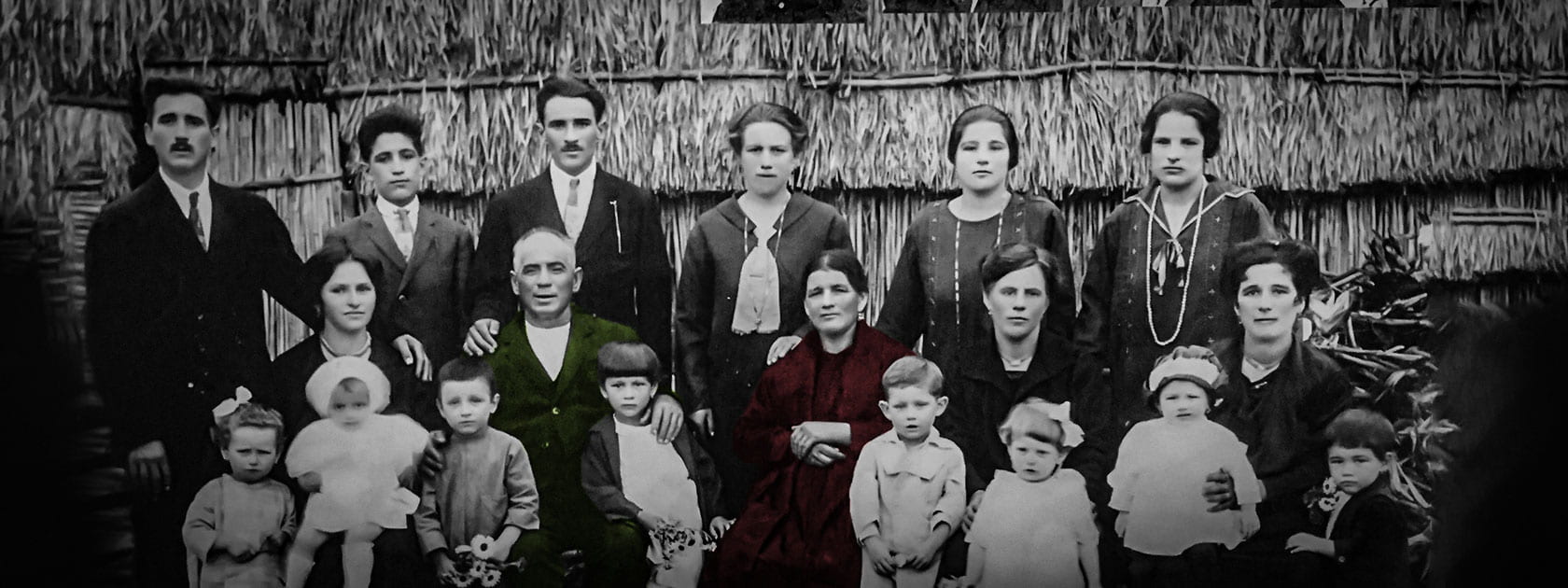Nincheri, Guido Michele: Sketches & Artwork

Charcoal Sketch of Luigi Pancaro
DATE
August 1940
MAKER
Guido Nincheri
CREDIT LINE
Courtesy of Maggie Pancaro Pallotta
This charcoal sketch of Luigi Pancaro was created by fellow internee Guido Nincheri in Petawawa Internment Camp. On the lower right hand corner, we see the artist’s signature followed by “Agosto MCMXL”. This is the Italian and Roman numeral date for August 1940, and does not follow the Fascist dating system seen in other sketches by the artist Guido Casini (see DICEA2011.0001.0036).
Guido Nincheri has been described as one of the most important religious artists in Canadian history. He certainly was prolific, producing a range of work in many mediums. His fresco featuring Benito Mussolini in the Madonna della Difesa church was likley the primary cause of his internment. In Petawawa Internment Camp, both he and Guido Casini created sketches of fellow internees. Vincenzo Poggi completed sketches as well as paintings while in camp.
Luigi Pancaro was a surgeon. While interned, he worked at the camp hospital, providing medical care to fellow internees and on occassion to camp guards and officials.

Colour Sketch of Leopoldo Mascioli
DATE
August 1940
MAKER
Vincent (Vincenzo) Poggi
CREDIT LINE
With the permission of Mascioli Family
This colour sketch of Leopoldo (Leo) Mascioli was created by fellow internee Vincenzo Poggi in Petawawa Internment Camp. The lower left hand of the drawing features a note to Mascioli as follows, “all. Eg. Leo Mascioli, con stima.” It is followed by the artist’s signature and the date the sketch was created, August 1940.
Leo Mascioli traveled to the United States at the age of 10. He was accompanied by a distant relative and landed in Boston where he worked as a shoeshine and a newsboy before finding employment in local restaurants. At the age of 19, Mascioli overheard an employment agent extolling the opportunities and adventures one could have in Canada. He traveled to Canada where he took a six-month contract working for a steel company in Sydney, NS. Leo soon took to working at various mines and slowly making his way to Timmins, ON. In 1911, he opened a general store in that town. A few years later Leo began building hotels and movie theatres in various towns in northern Ontario. On 10 June 1940, Leo Mascioli and his brother Antonio were arrested by the RCMP and accused of involvement in fascist organizations in both Timmins and Italy. Mascioli was 64 years old at the time and had been a citizen (a naturalized British subject) since 1921.
Vincenzo Poggi was an artist. In 1929, Poggi arrived in Montreal for a six-month contract to work for Guido Nincheri’s (also interned) stained glass studio in Montreal. At the end of his contract, Poggi decided to stay in Canada. He continued to work for Nincheri until 1940, when he was interned. Poggi began his artistic career as a portrait painter, but he found it nerve-racking to paint while trying to maintain a conversation with the sitter. He eventually switched to stained glass windows. Poggi created a number of paintings and sketches of fellow internees and of the camp while he was interned, many of which are now housed at the Canadian War Museum. He also taught his fellow internees to paint during his internment. Fellow internees and artists Guido Nincheri and Guido Casini did charcoal sketches of fellow internees while interned at Camp Petawawa.

Camillien Houde at Petawawa Camp
MAKER
Guido Nincheri
DATE
September 01, 1940
DIMENSIONS
13.2 x 10.8 inches
CREDIT LINE
Archives de la Ville de Montréal (VM6, D026.34-7-035)
INSCRIPTIONS
Recto:
(top centre of mat, handwritten in charcoal) -1940-
(bottom centre of mat, handwritten in charcoal) PETAWAWA
(centre left of sketch, handwritten in charcoal) G. NINCHERI [underlined] / SEPT. MCMXL
Sketch of Camillien Houde created by artist and fellow internee Guido Nincheri while Houde was interned at Camp Petawawa. In 1940 Camillien Houde was serving his second of four terms as mayor of Montreal. When World War II broke out Houde campaigned heavily against conscription. On August 2, 1940 he publicly urged men in Quebec to ignore the National Registration Act. Three days after this public declaration Houde was arrested by the RCMP and charged with sedition. He was sent to the Petawawa Internment Camp and did not recieve a trial. He was then transferred to Camp Fredericton where he stayed until his release on August 18, 1944. It was during his stay at these two World War II internment camps that Houde came into contact with many Italian Canadian internees.


Fresco in the Church of the Madonna della Difesa
DATE
2012
MAKER
Sophie Asselin
CREDIT LINE
Columbus Centre Collection
Fresco by Italian Canadian artist Guido Nincheri in the apse of the Church of the Madonna della Difesa in Montreal, QC.
The church is located in Montreal’s Little Italy and was built by Italian immigrants to Montreal in the early 1900s. It commemorates the apparition of the Madonna in La Difesa, in Casacalenda, Molise, Italy. The church was designed by Roch Montbriant and is Romanesque in style. The interior of the church was decorated by Guido Nincheri. It was consecrated in 1919.
The fresco in the apse of the church features Benito Mussolini on horseback and commemorates his signing of the Latern Treaty in 1929, which made the Vatican a sovereign state and enshrined Catholicism as Italy’s state religion. The fresco was painted by Nincheri, with assistance from other artists such as Guido Casini, in the early 1930s, with the grand unveiling taking place on September 24, 1933.
Once Italy declared war on the Allies, Nincheri’s fresco became politically suspect and he was arrested and interned. Guido Casini was also interned. The fresco was covered with a tarp for the duration of the war. Following Nincheri’s arrest, his wife Giulia tried to convince Canadian authorities that the church’s curate, Father Manfriani, forced Nincheri to include Mussolini in the fresco. According to Giulia, Nincheri would have risked losing the contract if he had not complied. She even provided original sketches of the fresco that did not include the dictator.
Nincheri was released from Camp Petawawa on October 22, 1940. After his release he continued to work on religious art and created more than one hundred frescoes and stained glass during his career. Guido Nincheri has been described as one of the most important religious artists in Canadian history.



